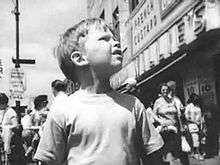Morris Engel
| Morris Engel | |
|---|---|
| Born |
Morris Engel April 8, 1918 Brooklyn, New York |
| Died |
March 5, 2005 (aged 86) New York City |
| Nationality | American |
| Known for | Filmmaking, Cinematography, Photography |
| Notable work | Little Fugitive (1952), Lovers and Lollipops (1955) Weddings and Babies (1960) |
| Movement | French New Wave |
| Spouse(s) | Ruth Orkin |
Morris Engel (April 8, 1918 – 5 March 2005) was an American photographer, cinematographer and filmmaker best known for directing the 1953 film Little Fugitive in collaboration with his wife, photographer Ruth Orkin, and their friend, writer Raymond Abrashkin.
Engel completed two more features during the 1950s, Lovers and Lollipops (1956) and Weddings and Babies (1960).
Engel was a pioneer in the use of hand-held cameras and nonprofessional actors in his films, using cameras that he helped design, and his naturalistic films influenced future prominent independent and French New Wave filmmakers.[1]
Career
A lifelong New Yorker, Morris Engel was born in Brooklyn in 1918. After joining the Photo League in 1936, Engel had his first exhibition in 1939, at the New School for Social Research.[2] He worked briefly as a photographer for the Leftist newspaper PM[2] before joining the United States Navy as a combat photographer from 1941 to 1946 in World War II.[2] After the war, he returned to New York where he again was an active Photo League member, teaching workshop classes and serving as co-chair of a project group focusing on postwar labor issues.[3]

In 1953, Engel, along with his girlfriend, fellow photographer Ruth Orkin, and his former colleague at PM, Raymond Abrashkin, made Little Fugitive for $30,000, shooting the film on location with hand-held 35mm camera. The film, one of the first successful American "independent films" earned them an Academy Award nomination for Best Writing, Motion Picture Story and a Silver Lion at the Venice Film Festival. The film told the story of a seven-year-old boy, played by Richie Andrusco, who runs away from home and spends the day at Coney Island. Andrusco never appeared in another film, and the other performers were mainly nonprofessionals. Though the film was a critical success,[4] Engel and Orkin, who had since married, had a hard time finding funding [4] for their next film, Lovers and Lollipops, which was completed in 1955. The film was about a widowed mother dating an old friend, and how her young daughter complicates their budding relationship.

Like Little Fugitive, Lovers and Lollipops was filmed with a hand-held 35 millimeter camera that did not allow simultaneous sound recording. The sound of both films was dubbed later. Lovers and Lollipops was followed two years later by the more adult-centered Weddings and Babies, a film about an aspiring photographer than is often seen as autobiographical. This was Engel's only film to have live sound recorded at the time of filming. Weddings and Babies was the first 35 mm fiction film made with a portable camera equipped for synchronized sound.[5]
In the 1960s, Engel directed a variety of television commercials.[6] He made a fourth film in the late 1960s[2] called I Need a Ride to California (83 minutes), which followed a group of hippies in Greenwich Village, but it was never released.[6]
Legacy
Engel and Orkin's work occupy a pivotal position in the independent and art film scene of the 1950s, and was influential on John Cassavetes, Martin Scorsese and François Truffaut[1][4][7] and was frequently cited as an example by the influential film theorist Siegfried Kracauer.[8]
Writing in Cassavetes on Cassavetes, biographer Raymond Carney says that Cassavetes was familiar with the work of the New York-based independent filmmakers who preceded him, and was "particularly fond" of Engel's three films. Carney writes that "Commentators who regard him as the 'first independent' are only displaying their ignorance of the history of independent American film, which goes back to the early 1950s.[9]
Truffaut was inspired by Little Fugitive's spontaneous production style when he created The 400 Blows (1959), saying long afterwards: “Our New Wave would never have come into being if it hadn’t been for the young American Morris Engel, who showed us the way to independent production with [this] fine movie.”[10]
Personal life
Engel and Orkin remained married until Orkin's death in 1985. In the 1980s, Engel began taking panoramic photographs[6] and in the 1990s, Engel returned to filmmaking, this time working on video. He completed two works: A Little Bit Pregnant[6] in 1994 and Camillia[6] in 1998.
Engel died of cancer in 2005.
Filmography
- The Little Fugitive (1953)
- Lovers and Lollipops (1956)
- Weddings and Babies (1960)
- I Need a Ride to California (1968) (possibly unfinished)
- A Little Big Pregnant (1994)
- Camillia (1998)
Recent Exhibitions (Selection)
- November 4, 2011 – March 25, 2012 "The Radical Camera: New York's Photo League, 1936–1951" at The Jewish Museum, New York
- August 20 – August 29, 2005 Morris Engel's Weddings and Babies: Newly Preserved at Museum of Modern Art, New York
References
- 1 2 King, Geoff (2005). American independent cinema. I.B.Tauris. pp. 108–109. ISBN 978-1-85043-938-7.
- 1 2 3 4 Film Buff Online: In Remembrance – Morris Engel
- ↑ Morris Engel bio on The Jewish Museum
- 1 2 3 Morris Engel and Ruth Orkin at Bright Lights Film Journal
- ↑ Ellis, Jack C.; Betsy A. McLane (2005). A New History of Documentary Film. Continuum International Publishing Group. pp. 209–210. ISBN 978-0-8264-1750-3.
- 1 2 3 4 5 Morris Engel Bio from Engelphoto.com
- ↑ New York Times Obituary
- ↑ Kracauer, Siegfried. Theory of Film: The Redemption of Physical Reality.
- ↑ Cassavetes, John; Carney, Raymond; Carney, Ray (2001). Cassavetes on Cassavetes. London: Faber. pp. 59–60. ISBN 978-0-571-20157-0.
- ↑ Sterritt, David. "Lovers and Lollipops". TCM.com. Turner Classic Movies. Retrieved 2009-04-18.